Monsters & Other Childish Things by Tollymain
Introduction
Original SA post Mr. Cuddles is my pet spidermonkey. He comes to school with me every day. He is very small, so he can fit in my pocket. He likes to go to the park, to play with the Chihuahuas. (They are about as big as he is.)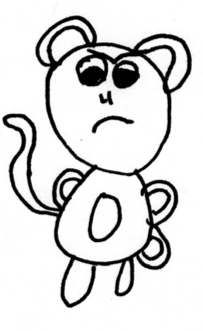
The one thing that Mr. Cuddles HATES is people who pick on me. If we are walking down the hall, and I run into someone mean, Mr. Cuddle will jump out of my pocket and rip out their eye balls. After that, I had to force him to put them back in. Then, I got detention. Mr. Cuddles is black with some dark brown splotches. When someone is around, he acts like a stuffed animal. The one thing everyone loves about him is his long tail. Sometimes, when he is in a good mood, he lets the girls use it as a jumprope. the downside is, is that when one of the girls trips, they land on and crush him. He rips out their eyeballs. There is also the way we communicate. we use sign language. It took me about two years to teach him, but he caught on in the end.
That's all about my monkey! You better go, before he rips out your eyeballs!
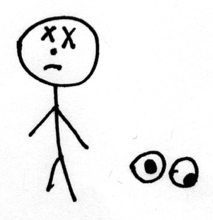
This little bit of intro fiction really does capture a great deal of the feel of setting for Monsters and Other Childish Things . MaOCT, as I'm going to abbreviate it for the majority of this review, is a game about children and their not-so-imaginary friends. And by friends I mean incredibly powerful creatures from somewhere out of town who don't quite obey the laws of physics as we understand them. Luckily we've got the children to hold them back!

That said, this is the first post of my review of MaOCT. Obligatory cover splash!
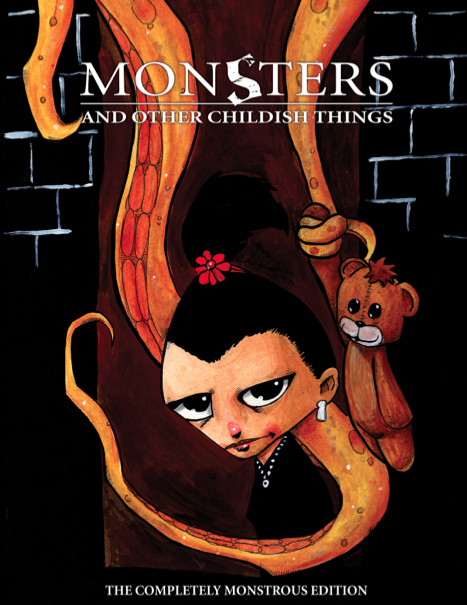
The book has a fairly standard table of contents, then we get hit with another bit of fiction to transition us into chapter 1: Introduction
"I didn’t know I wasn’t supposed to eat him.”
“Well, you did! Now what are we going to do?”
“Well . . . skip dinner, for one thing. I couldn’t eat another bite.”
“This isn’t funny.”
“It’s a little bit funny.”
“When they find out Dad’s boss got eaten, Dad is going to get fired, and then we’re going to have to move into a cardboard box behind the Sip’n’Dash, and I’ll have to share my corner of the box with Janie because we won’t be able to afford a box big enough for me to have my own space anymore!”
“You said that all in one breath.”
“I can swim all the way across the pool in one breath.”
“That’s pretty awesome. We should go swimming.”
“OK, but—hey! You distracted me!”
“I just want you to be happy. You worry about swimming all the way across the pool and BACK again in one breath, and let me worry about your Dad’s boss.”
“How? How are you going to fix this?”
“OK, give me a second . . . SMUUUUUUUUURGUAH! There.”
“That . . . how . . . Mr. Wilkins?”
“Sure! Ever since I kicked the crap out of Chameleon Pete last week, I can turn into anything I want.”
“No kidding! So like . . . you could turn into Miss July?”
“Easy peasy, my friend. Just let me eat her up, and I’m your dream girl.”
“Ah. . . . We’ll put that one on the ‘Maybe Later’ shelf, right?”
“Right.”
“Let’s get back downstairs before Mom starts worrying her meatloaf is cold.”
“I shudder to think of your mother’s meatloaf.”
“You just ate a full-grown CPA! With ballpoint pens and shoes and wallet.”
“He tasted like salty hot dogs.”
“I’m gonna barf.”
The quality of the writing in this book is something that I want to gush over, so I'll just say it right now. The writing (and not just the fiction bit between chapters either) of MaOCT is phenomenal. I'm going to avoid posting a ton of examples, but I will put a few here and there to
The introduction has the usual "What is roleplaying?" sidebar running next to a couple paragraphs explaining the basic idea of the game. MaOCT is about children and how they relate to the people and things they hold dear. One of those things happens to be a terrifying Thing from somewhere outside our reality. It goes on to say that the game is about children because that's the most vivid part of life, a part where the boundary between story and real life hasn't been built, reinforced with titanium, and salted with plutonium dust. Relationships are the most important things in a kids life, and conflicts that threaten those relationships can have quite literal life-changing stakes. Monsters often serve as a powerful force for creating and resolving such conflicts.
After that it goes on to explain monsters in a little more depth. There are several important facets to monsters. Monsters are like that imaginary friend you might have had as a child, except they're real. Also absolutely terrifying to most people who are not you. And they tend to cause property damage as well. Also they tend to get into fights with other monsters a lot. Some monsters just hate each other's guts on instinct, it seems. An instinct that can bleed over to the kid as well. Kids with monsters tend to form cliques with the other kids whose monsters they can get along with. Forget the plebs, right?

Monsters represent a couple things.
 Power
Power
 , for one. And
, for one. And
 unconditional friendship
unconditional friendship
 . And trouble. Lots of trouble. Monsters ain't people, it seems. They're amoral, capricious, and sometimes think that humans are tasty. People tend to run away screaming from them when they manifest themselves, and strange men in identical suits and white vans sometimes show up and bother you until your monster eats a few of them.
. And trouble. Lots of trouble. Monsters ain't people, it seems. They're amoral, capricious, and sometimes think that humans are tasty. People tend to run away screaming from them when they manifest themselves, and strange men in identical suits and white vans sometimes show up and bother you until your monster eats a few of them.
The book goes on to explain that in the course of play you use a few mechanics such as skills, stats, and relationships, which you keep track of on a character sheet. All pretty basic stuff. The book and I will go into detail about them later. This game is based on the One Roll Engine (ORE) System, a creation of Greg Stolze, if I recall correctly. This book was not created by him personally, rather it was written by Benjamin Baugh. At the moment I'm rather tired, so I'm not particularly sure if any ORE games have been covered in this thread; if not, I'll explain its core mechanic in detail later on in the review.
To play the game, all you need is paper, pencils, some d10s, and friends willing to try out this weird game with you. (Alternatively, a computer with an internet connection
 )
)
This game is, in its intended format, supposed to be driven by the tight-rope walk between the struggles of normal childhood such as school and family as such and the craziness that monsters bring into their kids' lives. Neglect either, and Bad Things can happen.
Next time: Character Creation
Characters
Original SA post Monsters and Other Childish Things: Characters
Wow, this is a pretty interesting juxtaposition to Little Fears, I'll say that much.
This is going to be a pretty simple write-up here, if only because character creation in MaOCT is very, very simple. Children, as stated before, have stats , skills , and relationships . All of these are represented by ratings of X d , where X is the number of d10s put into that category.
Stats are basic abilities and strengths. [/b]Skills[/b] are more specialized, and organized under the stats in a fairly straightforward way.
Feet governs the skills of Dodging , Kicking[/b], and P.E. . Dodging and Kicking are fairly obvious and well-defined by their names alone. P.E. is the pertinent skill to climbing, jumping, running, and basically any other form of motion that doesn't involve riding things.
Guts is largely a passive sort of stat, dealing mostly with physical and intestinal fortitude. Courage is the fear and sanity check skill, used against both normal things (such as bullies like Tommy Heckles) and decidedly less normal things (like Tommy Heckles' monster Fangs McMauler). Wind is the skill that you use to not double over in pain after getting slugged in the belly by Tommy, or to avoid falling over wheezing when running from Tommy's monster. The last Guts skill, Wrestling , is a bit more proactive. It's good for overpowering, restraining, and squeezing the fight out of other kids (and probably some weedier adults, if you're really good).
Hands is your stat for doing things that, you guessed it, use your hands. You can use Punching to hit things, Blocking to use a thing to keep those things from hitting you in the thing, and Shop to do useful things to or with inanimate things.
Brains is your mental stat. Your Notice skill is seeing the devil in the details. Seeing as this is MaOCT, that devil may not be metaphorical. Hope you've got sharp eyes! Out-Think is for the times when you need to think on your feet. Very useful during conflicts. Remember is book smarts and what-not, the massive coke-bottle glasses come optional with a high rating in this skill.
Finally we've got Face , the social stat. The fast-talking 'diplomacy' skill is Charm ; good for sweet-talking teachers and making friends. When you need to lie your ass off to somebody or hide something, you better hope you have a high rating for Connive , or they'll probably see right through you. And for when you just want to send the other person crying home in tears. Putdown is your best friend.
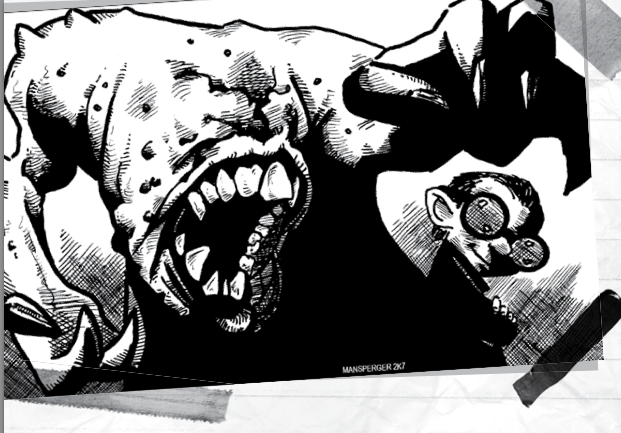
I have the feeling this kid has pretty damn good Face and Connive ratings.
In a sidebar titled “Special and Unique Snowflakes” , the game gives GMs the option of allowing players to make up unique skills with examples like ”Mad L33T Hacking Skillz“ , ”Got a Learner’s Permit “ , and ”Dark Secrets of the Elder Gods .“

When creating a character, you start with 1d in each stat, and another 10d to distribute among the stats however you please. Each stat can be raised to a maximum of 5d. It is possible to create a perfectly average kid with 3d in each stat, but that'd be kind of boring, wouldn't it? Far more interesting to create a child prodigy with the constitution of a wet piece of paper, or a big lug with no social skills, or a track star who's as dumb as a post.
Skills don't have the required minimum 1d. Instead you get 15d to distribute to any skills you like (including the aforementioned made-up ones, with your GM's blessing) to a maximum of 5d, and can complete neglect those that don't interest you.
In gameplay, most tasks are resolved using a stat and a skill to create a pool of dice, which are then rolled. The results are then organized into sets based on the numbers on the top face, which indicate different things depending on the size of the set (the Width ) and the face number of the dice [the Height ) in the set. Sets are expressed as Width x Height. Width indicates the speed at which the action is achieved, while Height indicates the finesse of the success. When a player rolls multiple resulting sets, he gets to use whichever set he wants.
For example, little Johnny is running away from a bully. He's pretty quick with a Feet rating of 4 and a P.E. rating of 2. The bully's bigger, but not quite as nimble with a rating of 3 and 1, respectively. Johnny rolls 6d, getting a result of 2, 2, 2, 6, 7, and 9. The bully rolls 4d resulting in 2, 3, 10, and 10. The bully has a set of 2x10, while Johnny has one set of 3x2. In this conflict, speed is a better priority then quality; after all, Johnny might have beautiful running form but that won't help you when the bully catches up to him and smashes his face into the dirt. Thankfully, Johnny has a greater Width in his result. The player and GM decide that Johnny managed to scramble away, though in a completely ungraceful fashion.
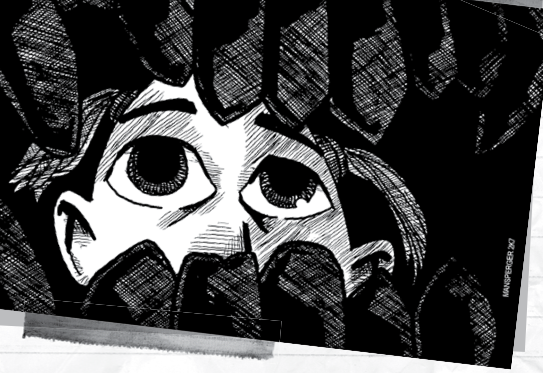
I'm not sure what's going on here. Is her monster carrying her in its mouth or something?
The book points out that the GM should only ask the player for a roll outside of conflicts when an action is something really tricky, because failing to be able to do simple things just slows down the game and annoys the players. Unopposed rolls usually only need a single successful set with a Width of 2 or more. Particularly difficult things might require a minimum height, but this is a mechanic best used sparingly.
When a player rolls the dice and comes up with no sets and no dice with a result above 5, the GM can rule that a Botch has occurred. When this happens, the player fails and fails hard. For example, instead of making the weird glue-eating kid go away with your Putdown skill, you make him mad and he decides to punch him in the face. Not only do you lose the race, but you trip over your own feet and look like an idiot. The book does not mention this, but if you can get at least 6 dice into your roll, it's impossible to botch.
Next time: Character Creation Part II and Relationship Mechanics .